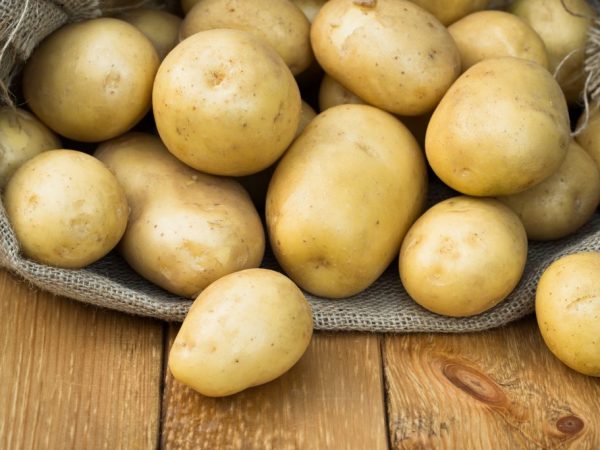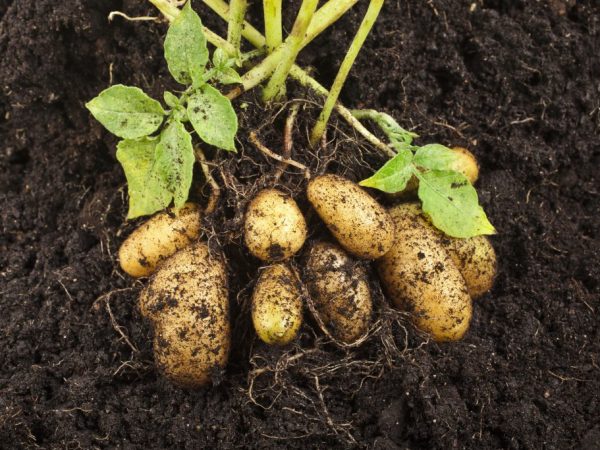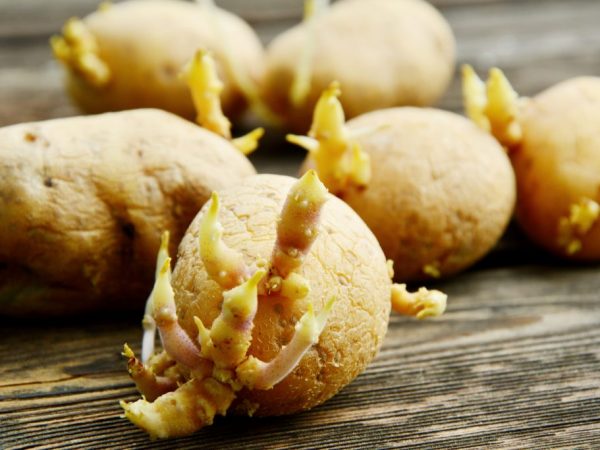Characteristics of Skarb potatoes
The most popular vegetable crop in the world is potatoes. Residents of any country can offer national potato dishes to consumers. Therefore, neither the farms nor the owners of their own gardens refuse to grow this vegetable. Among the many varieties, you can choose those that will satisfy the highest requirements for product quality, ripening time and taste. Skarb potatoes deserve special attention, thanks to the positive reviews about it, experienced potato growers.

Characteristics of Skarb potatoes
Plant characteristic
This vegetable belongs to the mid-ripening species. There are many interesting things to tell about him, besides the name, which means Treasure.
- It can be grown throughout the country, except for Siberia and the Northern regions.
- On day 85, the tubers reach technical maturity.
- The productivity of the bushes is high.
- The plant is unpretentious to care for.
- The tubers are well kept and transportable.
In the central zone of the country, Skarb potatoes can give 70 tons of products per hectare, subject to all the recommendations for growing. Potatoes can bear fruit on poor soils, and they are not demanding for watering.
If the tubers are damaged during harvesting, then you need to give them time for the sections to dry. These potatoes can be stored along with the rest, until the next harvest. A unique feature of potatoes is their exceptional keeping quality. Tubers, practically until next autumn, do not lose their presentation and retain all their taste.
Such products can be sold at a time when other varieties have already become flabby. The Scarb potato variety is easy to transport over long distances. In this case, the tubers are not injured and do not get dents.
Positive sides
The pluses include many indicators, along with yield.
- Scarb potatoes have excellent taste.
- The average weight of tubers is about 180g.
- The output of marketable products is up to 95%.
- Potatoes are suitable for all types of culinary processing.
- The variety is resistant to many viruses that infect nightshade crops.
A sufficiently high starch content, about 17%, prevents the vegetable from boiling and crumbling during heat treatment.
This characteristic allows boiled potatoes to be used as an ingredient in various salads. If you boil it for a long time, you can make a puree that will be lush and delicate milky.
The plant is immune to potato cancer, leaf mosaic, blackleg of stems and dry and wet fruit rot. In areas where this variety grows, golden nematodes are rarely found. But in order to completely protect your Scarb potatoes, it is not recommended to grow it for about 4 years in areas where tomatoes, peppers, pumpkins and other varieties of potatoes had previously grown.
Disadvantages of potatoes
The scourge of all nightshade crops - the Colorado potato beetle, can damage the plantings of this potato. In a rainy summer, there is a threat of damage to the stems by late blight and black leg if spores are brought in from neighboring areas. There is a partial curling of leaves and fruit scab.
Sometimes tubers get sick with ring rot. If such a phenomenon is found on them, then they become unusable. Such potatoes are also not suitable for breeding.
Some medium and late ripening varieties can be planted without prior germination. But our potato variety Scarb is necessarily germinated. Another disadvantage, but not affecting the yield, is the uneven germination and unstable flowering of the plant.
Description of the plant

After harvesting tubers need to be dried
Scarb potatoes have semi-spreading bushes, up to 60cm high. It has up to 8 stems in each fruit nest. They are ribbed, without edges, light green in color, sometimes with yellowness.
There are many leaves on the plant, but the lower part of the stem is often bare. Potato-type leaf plate, without waviness at the edges. The veins are poorly expressed, therefore, the corrugation of the leaves is small. The color is deep green, with an excess of nitrogen fertilizers - a dark green tint.
The stems bear a simple inflorescence at the top, consisting of 10 flowers. The corollas of the flower are fused, snow-white in color. The stamens are crowded, orange. The pistil protrudes 0.5 cm above the cone of stamens. Flowers are pollinated naturally.
After pollination, the berries are partially tied, which, for the most part, crumble. About 12 green berries remain on the bushes, they can be torn off by hand. They bear few seeds. Seed fruits are poisonous. The presence or absence of berries does not affect the yield.
When growing Scarb potatoes, and considering the description of the variety, you need to pay attention to the way it is harvested. For 2 weeks, before digging out the tubers, you need to cut and remove the tops from the site.
Tubers are laid out for drying and sorted: for consumption, for planting material and separately, damaged during digging. Diseased tubers, or potatoes with suspected disease, are best destroyed.
Description of tubers
Up to 15 tubers ripen in each bush. They are almost the same size and weigh from 160g to 250g. The shape is rounded oblong. The peel is smooth, without roughness and grooves. The color of the peel is uniformly golden or deep yellow.
The eyes are evenly spaced over the entire surface of the tuber. Their good feature is that they do not germinate when stored in basements. But this property obliges gardeners to warm up the tubers before germination.
The sugar content of the potatoes is about 0.4%, which gives a sweetish taste. Dry matter in potatoes is more than 20%. This allows crispy fries and chips to be cooked.
Preparing the soil for potatoes
The description and characteristics of the crop says that this variety can be grown on almost any soil. But in clay areas, ridges are formed, into which a well-rotted mullein is added. This improves the structure of the soil, from heavy soil to loose soil.
In other vegetable gardens, green manures such as mustard and barley can be planted in early autumn. With a growth of about 30 cm, they are embedded in the ground when digging. Instead of siderates, up to 45 buckets of humus are brought in for 1 hundred square meters, leveled and dug deeply.
Ammonium nitrate, superphosphate and wood ash are scattered in the spring. It is possible, on the surface of the soil before filling the holes, but it is better to apply directly to the planting holes. Then the plant will immediately receive nutrients.
Seed preparation

Tubers for planting must be healthy
A month before warm weather sets in, tubers are taken out of the basement. Potatoes cooked in the fall are again carefully inspected for dry or wet rot, scab and visible damage. For planting, completely healthy tubers are selected, preferably of the same size.
They are heated at a temperature of about 35 ° C throughout the day. Then they are laid out in one layer in boxes and exposed to light at room temperature for germination and gardening. After the sprouts reach a height of 3.5 - 4 cm, they can be planted. Before planting, treatment with Prestige is recommended
Planting tubers
When the weather is warm and the ambient temperature is at least 15 ° C, and the soil is at least 10 ° C, you can start planting. If necessary, ridges up to 30 cm high are formed and placed from north to south. This arrangement, both of the ridges and rows, will serve to better warm up the rows and illuminate the bushes. The width between them is allowed 60cm. They dig planting holes with a depth of about 10 cm and a distance, one from another, no more than 25 cm.
Mineral fertilizers are added to the wells, in a teaspoon:
- superphosphate;
- potassium salt;
- potassium chloride.
You can also put handfuls of onion husks and wood ash. In the gardens, in the pits, you need to put potatoes, strong sprouts up, and carefully, so as not to break them, fill them with soil.
Growing potatoes
After the appearance of the first shoots, and they germinate unevenly, the bushes slightly huddle, protecting the plants from night frosts. Further planting care comes down to such activities as:
- watering;
- weeding and loosening;
- fertilizer;
- prevention of viruses and diseases;
- insect control.
Plants need to be watered at least 3 times during the entire growing season. If the summer is rainy, then they are limited to loosening the soil and weeding. Weeds must be removed carefully to avoid injury to young tubers that are located in the top layer of the soil.
Fertilizing plantings
You can feed potatoes by spraying the aboveground part of the bush with boric acid. The first feeding is the introduction of drugs into the pits. The second is carried out during the formation of flower buds, and the third is carried out when the seed berries ripen.
A mixture of dry fertilizers with humus is applied directly to the area of the hole and the plants are spud. With the ingress of moisture, the mixture will dissolve and the plants will receive a full-fledged top dressing.
Disease and insect control
In order not to have to treat diseased plants, it is better to first carry out preventive treatment of the bushes. From the occurrence of late blight of the stems, the bushes will protect 1% solutions of Bordeaux mixture or copper sulfate. Process them by spraying. The appearance of a black leg will stop spraying the plantings with a 3% manganese solution or trimming them with ash.
The Colorado potato beetle can be harvested by hand, and after the massive appearance of the larvae, biological preparations such as Bitoxibacillin and Fitoverm are used. Of insecticides, Aktara, Corado and Confidor are suitable.
From the wireworm, they are treated with Provotox, and from the bear - Medvetox or Grizzly. The moth caterpillar is destroyed by the biological substance Nemabakt.
Conclusion
Scarb potatoes, subject to all requirements for agricultural technology and care, will be able to thank the gardener with large and healthy tubers. These potatoes are a real treasure that tastes great. Smooth golden potatoes are pleasant to store and sell surplus products. Beautiful and shiny vegetables will attract the attention of housewives. And aromatic dishes will impress even gourmets.

